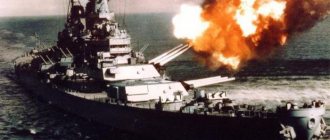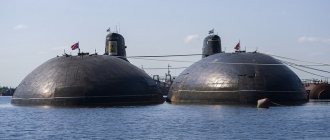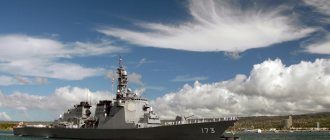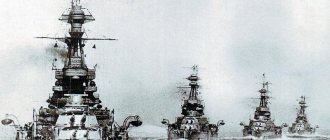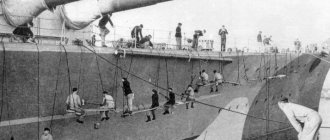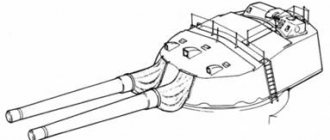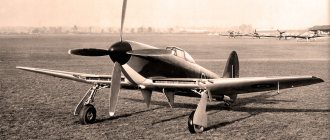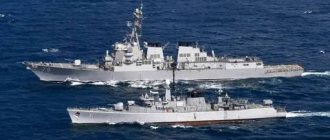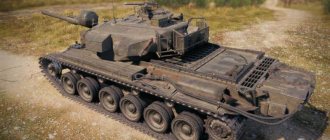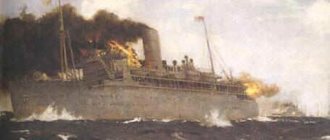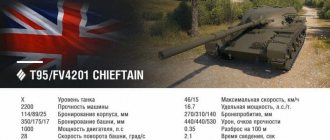Design and armor of the battleship Vanguard
The length of the ship was a record 248 meters - it was the largest battleship in Great Britain. The total displacement exceeded 51,000 tons. The original design had a hull identical to the King George V class. However, subsequently it was decided to raise the bow of the ship, since the predecessor often had water on the deck due to the low side. Thus, the height of the side in the middle of the ship was about 7 m, in the bow it was raised to 11 meters. The circulation diameter was 1000 m; for this size of the vessel these were quite acceptable figures.
Much attention was paid to waterproofness. In total, there were 1,059 isolated compartments in the lower part of the ship. In the event of a hole, the ship will remain afloat.
The armor was consistent with previous British battleships. The main armor belt was made of Krupp cemented armor up to 356 mm thick. The turrets of the 381 mm guns were lined with 305 mm and 343 mm steel plates. The lower part of the vessel was also protected similarly to the King George V class. In 1941, one of the ships of this type was sunk as a result of torpedoing. Experience has shown that the underwater protection of dreadnoughts is very weak. Despite this, virtually no changes were made to Vanguard. The defense consisted of three layers. The outer part was hollow, it served to distribute pressure over a large area. The middle compartment was filled with water - it extinguished the energy of the explosion. The inner area was also empty, it was supposed to distribute the remaining shock wave.
The engine power was 130,000 hp, which ensured a speed of 29.5 knots. The maximum performance was recorded in the initial tests; they reached 31.57 knots. The cruising range without refueling in economy mode was 8,400 miles.
Battleship Vanguard
“Vanguard” 02.10.1941 / 30.11.1944 / 09.08.1946 – scrapped 06.1960
The battleship Vanguard was the last battleship laid down in Britain and the world. It was designed in 1939-1941, due to the expected late commissioning of the Lion-class battleships, and was intended for urgent construction using the 381-mm gun mounts of the Glorious-class battlecruisers, which had been stored in warehouses since the 1920s. Despite the hasty construction, the battleship laid down in 1941 was not put into operation before the end of the war, and after the end of the war its completion slowed down even more. As a result, she was only accepted into service in 1946, joining the French battleship Jean Bart as the last battleships in history to enter service, as well as the largest of the British battleships. The battleship was used several times as a royal yacht and was decommissioned in 1960.
Displacement – 45,200 tons Total displacement – 52,250 tons Length – 248.3 m Width – 32.9 m Draft – 11.0 m Maximum speed – 31.57 knots Crew – 1995 people (115 officers) Reservation: Citadel belt – 343-356 mm with thinning to 114 mm along the lower edge Belt at the ends - 51-64 mm Deck - 150+37 mm above the cellars, 125 mm above the power plant, 64-125 mm at the ends, 114 mm above the tiller compartment Main battery tower - 343 mm forehead, 152 mm roof, 274 mm side, 76 mm floor Barbettes Main battery – 280-330 mm Traverses – 305 mm citadel, 100 mm tiller compartment Cabin – 75 mm forehead, 63 mm side, 25 mm roof, 25-51 mm anti-fragmentation protection Armament: Main caliber - 4 × 2 - 381 mm/42 Mk.I/N RP 12 Universal artillery - 8 × 2 - 133 mm/50 Mk.I Anti-aircraft artillery: 10 × 6 - 40 mm/60 Bofors 1 × 2 — 40-mm/60 Bofors 11 × 1 — 40-mm/60 Bofors No torpedo armament No missile armament No aircraft armament, helicopters were occasionally used Fire control systems and electronic weapons: Artillery radars: 2 × Type 274 fire control main battery 4 × Type 275 universal artillery fire control 11 × Type 262 anti-aircraft artillery fire control Other radars: 1 × Type 960 combined aircraft and ship detection radar 1 × Type 293 target designation radar 1 × Type 277 ship and low-flying target detection radar 1 x Type 268 navigation radar 1 x Type 930 navigation radar Other systems: “Friend or Foe” system VHF direction finders Jamming devices Engine – 4 Parsons turbines Boilers – 8 triple water tube boilers of the Admiralty type Power – 130,000 hp estimated, up to 135,560 hp on tests Maximum speed - 31.57 knots Cruising range: 8400 miles at 14 knots 6950 miles at 20 knots 5350 miles at 25 knots 3380 miles at 28 knots 3600 miles at 29.5 knots
Armament of the battleship "Vangard"
- The main caliber included 4 towers, each of which had two naval guns with a caliber of 381 mm, BL 15″/42 Mark I. New dreadnoughts of other countries had more powerful weapons, but this choice was due to the fact that the guns were already available in availability - there was no need to spend money on their production. The equipment was evenly placed in the bow and stern parts. The firing range was 22.5 km.
- The 133-mm universal artillery 5.25″ QF Mark I consisted of 16 units.
- Anti-aircraft artillery included QF 2 pounder Mark VIII multi-barrel guns and 40 mm Bofors machine guns.
Vanguard - the last British battleship
Vanguard - the last British battleship
The main obstacle that thwarted the construction of the “lyons” was the long time frame for the development and introduction into production of new artillery guns and their installations. In 1939, the situation with 356-mm turrets for the King George V type remained close to critical, not to mention the fact that 14-inch turrets did not satisfy the British admirals in terms of power. The new 406 mm gun was only in the drawings. Meanwhile, the expected balance of power with the main potential opponents in the future, even before the start of the World War, did not look very promising for England. The Admiralty was almost completely unaware of the new Japanese construction, having no reliable data on the Yamato-class superbattleships. But even distorted by the lack of intelligence, the picture looked disappointing. At the end of 1943, it was assumed that in the European theater Britain would be able to oppose the German Scharnhorst and Gneisenau and 5 subsequent German ships with the Home Fleet consisting of 2 Lions, 5 Kings, Hood and weak Repulse and "Rinauna." British experts believed that at the same time in the Far East, 10 old Japanese battleships would be joined by 4 new ones with 16-inch weapons and 2 battlecruisers with 320 mm guns. They could be resisted only by 2 Lions, 2 Nelsons, 5 modernized Queen Elizabeths and about 3 hopelessly outdated slow-moving R tanks. Although the picture looks greatly distorted, it qualitatively reflected the possible balance of forces. Prospects in the Pacific looked particularly unfavorable. The British fleet there was significantly inferior to the enemy in terms of high-speed ships. The battlecruisers were supposed to be held against the Germans, so the appearance of another high-speed battleship would be very useful.
The current situation forced us to pay attention to the 381-mm Mk I turrets manufactured in 1916 lying in storage. The simplest solution was to create a new hull for the old turrets, which were supposed to be modernized for subsequent service for 25 years! Removing the 35,000-ton limit made it possible to create a good ship with a displacement of about 40,000 tons with a speed of 30 knots and good protection. It was assumed that although it would not be a full-fledged participant in the “battle line,” it would prove very useful as a well-armored battle cruiser, a kind of modern analogue of the Hood. The Admiralty believed that he could become a hunter for hypothetical Japanese battle cruisers with 320 mm guns and very real heavy cruisers, which the British could not oppose with their own either in quality or quantity. If necessary, the "neo-Hood" was able to fight with 16-inch opponents. Long-term plans went even further. Strategists believed that the zone of action of such a “hybrid” could be the Indian Ocean and the waters of Australia, which was supposed to “fuse” the not entirely full-fledged unit if events developed successfully. Further, after the Royal Sovereign-class battleships were removed from the fleet, additional 381-mm installations were freed up, which could be installed on sisterships if the lead ship was successful.
After positive feedback from the Naval Staff, the naval design department was tasked with developing a preliminary design for a new battleship with specifications corresponding to 40,000 tons, 30 knots and eight 381 mm guns. Calculations were made for 3 options, of which the first, “15A”, was a kind of “initiative development”, since it was started even before the official request (hence its displacement is about 38,000 tons). Option "15C" differed from "15B" only in that it provided for the use of a block of machines and boilers for "lyons", which could save time and money, since all the drawings were already available. However, the main shipbuilding experts recognized “15B” as the best. Nevertheless, they decided to build “15C”, mainly for reasons of every possible reduction in time. The Naval Design Department received the task of preparing working drawings and actively began to implement it.
The progress of the design work was interrupted by the Second World War. 8 days after it began, on September 11, 1939, development was suspended indefinitely. The project was pulled out of hiding in December when Winston Churchill showed interest in it. The head of the fleet, known for his extreme activity, liked him because of the opportunity to quickly get a new and fully combat-ready ship. Churchill gave the order, and in February 1940 work on the project resumed. At the next meeting of the Admiralty Council, held on February 27, adjustments were made to the terms of reference, mainly related to strengthening protection. In particular, it was planned to install a thin belt at the extremities, increase the thickness of the armor of the casemates (turret compartments) of the auxiliary artillery and equip an armored auxiliary steering post in the stern. These useful measures were “attached” to the requirement to deploy 4 installations of UP anti-aircraft unguided missiles, heavy, absolutely useless, but popular at that time among Admiralty specialists. The only positive aspect of this decision was the reservation of space, which could later be used for multi-barreled anti-aircraft guns.
Taking into account the above requirements, the “15D” project was drawn up, corresponding to a displacement of 41,200 tons. The ship gradually “swelled” without acquiring fundamentally new combat qualities. This change was not the last, since the very first battles involving the battleships of the King George V class provided rich food for modifications and improvements. Their implementation required additional weight, to accommodate which it was necessary to increase the width of the hull by 1 m. In addition, the designers lost almost six months (from June to October 1940), when the more pressing needs of the fleet forced the drawings of the battleship to be put aside again. Only on April 17, 1941, the Admiralty Council finally adopted the “15E” version, which could be considered final.
